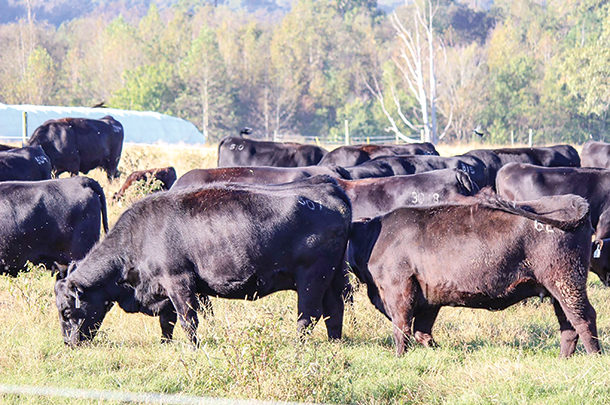The challenge with this variety, however, is the ergot alkaloid toxins it produces (fescue toxicosis syndrome), resulting in decreased feed intake and growth performance, compromised reproduction, elevated respiration and body temperature, reduced blood flow to the extremities, and reproductive failure.
Reproductive failure in cattle due to fescue toxicosis has been attributed to altered ovarian follicle development, ovarian dysfunction, early embryonic loss and reduced hormone concentrations, all subsequently leading to reduced pregnancy and calving rates. Although fescue toxicosis has been a challenge for years, the complex nature of this syndrome leads to high variability in animal response due to seasonal or annual fluctuations in toxin load, in combination with the age and genetic background of the animal or elevated environmental temperature.
Consequently, this has hindered our ability to alleviate the symptoms of fescue toxicosis. Thus, this article will describe the impact of fescue toxicosis on reproductive success following use of reproductive technologies and potential strategies to mitigate the negative effects on reproductive performance.
A.I. and estrous synchronization
The precise mechanisms of how or at what stage of the reproductive cycle toxic fescue alters the reproductive tract remains unknown; however, there is clear evidence that it negatively impacts artificial insemination (A.I.) pregnancy rates and animals’ response to estrous synchronization. Pregnancy rates following A.I. are generally lower in females exposed to toxic fescue pastures compared to females on nontoxic pastures. In a North Carolina State University study, A.I. conception rates in replacement beef heifers exposed to high or low levels of toxic fescue were tracked over a three-year period.
Conception rates in the replacement beef heifers exposed to high toxic fescue were 47% compared to 64% in heifers exposed to low toxic fescue, thus supporting the negative impact of fescue toxicosis on A.I. success. Additional research has demonstrated that grazing toxic pastures prior to or switching to toxic pastures following A.I. resulted in decreased pregnancy rates in cows compared to cows grazing nontoxic pastures; however, it remains unclear whether the pregnancy loss in this case occurred due to poor oocyte quality, reduced fertilization rates or hindered early embryonic development.
Estrous or ovulation synchronization in beef cattle involves manipulating the females’ estrous cycle, through hormone supplementation, to reset the follicular waves on the ovary so they will ovulate and be inseminated at the same time. Reproductive organs release hormones into the bloodstream, which carries them to other reproductive tissues to stimulate the desired response to regulate the reproductive processes, which is critical for success of synchronization programs.
Fescue toxins have vasoconstrictive actions on the blood vessels, and studies using Doppler ultrasonography have shown reduced blood flow to the tail and feet in animals exposed to toxic fescue compared to animals consuming nontoxic fescue. Research shows chronic exposure to toxic fescue seed decreased the diameter of the arteries and blood flow leading to the uterus and ovaries. This suggests that fescue toxicosis restricts blood flow and limits hormone signals and nutrients to the ovaries, potentially leading to reduced responsiveness of hormonal supplementation during estrous synchronization programs. In follow-up studies focused on follicular development, several others have observed a decrease in the diameter and number of large follicles in heifers consuming toxic fescue compared to heifers on nontoxic feeds.
Heat stress
Additionally, many of the symptoms of fescue toxicosis in cattle are amplified during periods of heat stress when the animal lacks the ability to maintain a thermoneutral body temperature. Recently, a genetic trait has been identified in Bos taurus-influenced breeds, Senepol and other Criollo breeds, which is associated with heat tolerance and a slick hair coat. A more recent study evaluated the effect of the slick trait and exposure to toxic fescue on follicular growth in heat-stressed beef heifers and discovered that heifers lacking the slick hair mutation and exposed to toxins had an increase in the number of small follicles, yet a decrease in the number of preovulatory follicles compared to the other heifer groups.
Intriguingly, this lack of follicular growth indicates a dysregulation during follicle development leading to reduced fertility that was not observed in heifers possessing the slick hair trait and exposed to toxins. Taken together, the changes in follicle growth due to fescue toxins, under both thermoneutral and heat-stress conditions, could result in females failing to respond to hormone supplementation during estrous synchronization.
Nontoxic varieties
Previous attempts to minimize fescue toxicosis have focused on altering the forage systems through developing new nontoxic fescue varieties or employment of intensive pasture management techniques. While advancements have been made in developing nontoxic fescue varieties, these varieties tend to be less persistent and will eventually be replaced by toxic fescue if not managed properly. Many beef producers are reluctant to make these changes because of the expense, labor and time to manage these approaches; therefore other animal-based solutions need to be available.
To improve reproductive success, beef producers can transition their herd from a spring-calving and early summer breeding system, when toxin loads are greatest, to a fall-calving and winter breeding system, when toxin loads are lowest. While genetics of fescue toxicosis are not completely understood, continued efforts to identify animals highly susceptible or tolerant to fescue toxicosis are needed. Improved recordkeeping to evaluate animal performance throughout the year will better identify animals potentially tolerant to fescue toxicosis. Additionally, introducing new traits, such as slick hair coat, into beef herds provides producers options to address fescue toxicosis and heat stress.
Lastly, we need to better understand how fescue toxins specifically impact reproductive organs so we can develop inventive tools, drug therapies and strategies to enhance best management practices for improved reproductive performance in cattle grazing toxic fescue. I would like to thank the North Carolina Cattlemen’s Association for their continued support of this research. ![]()
PHOTO: It is unclear at what stage of the reproductive cycle toxic fescue alters the reproductive tract, but there is clear evidence that it negatively impacts A.I. pregnancy rates and animals’ response to estrous synchronization. Photo by Daniel H. Poole.

-
Daniel H. Poole
- Associate Professor of Reproductive Physiology
- North Carolina State University
- Email Daniel H. Poole
0









